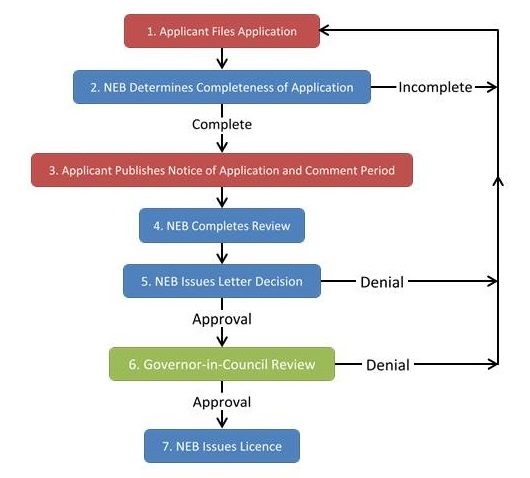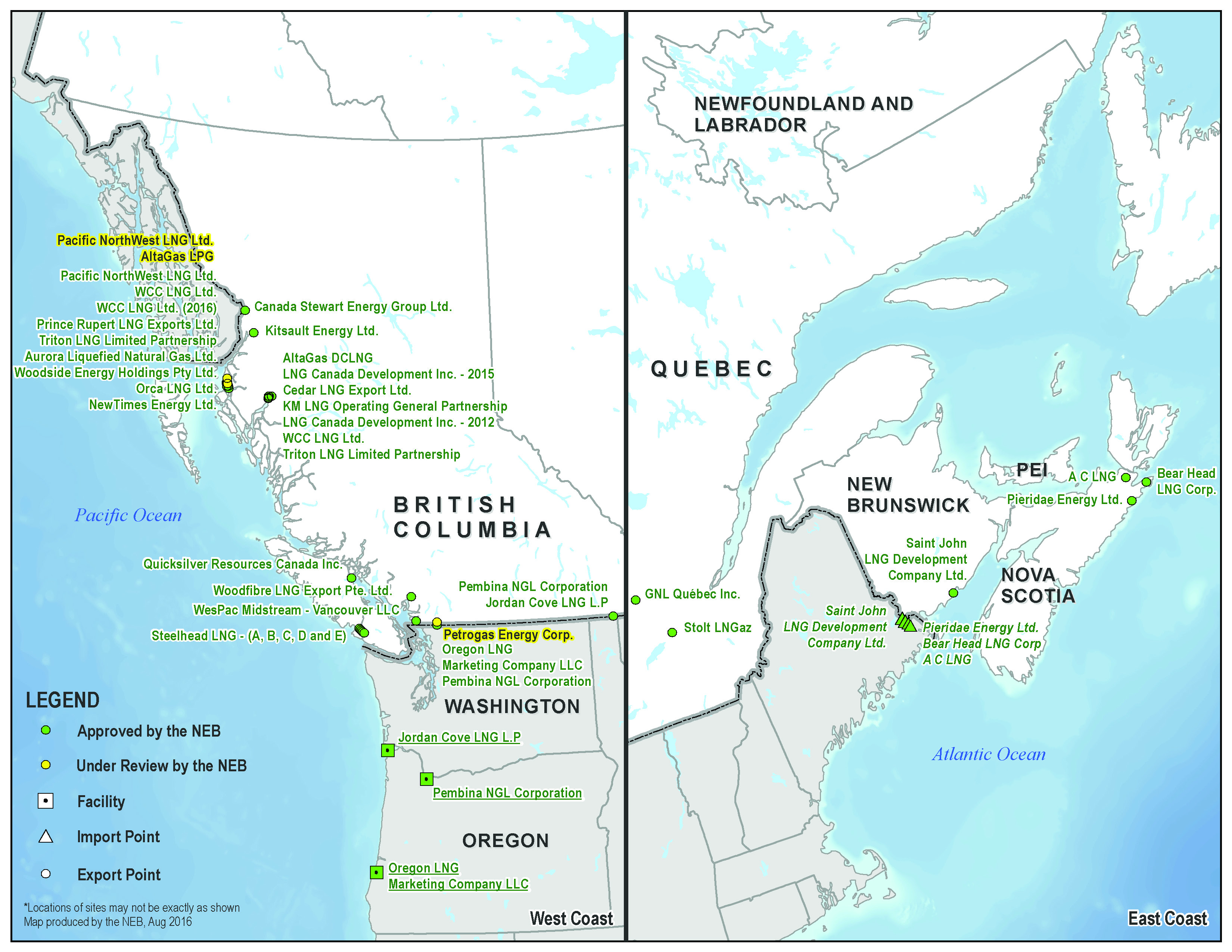Market Snapshot: Understanding the Regulatory Process for Oil and Gas Exports
Release date: 2016-08-11
Part VI of the National Energy Board Act (NEB Act) and related regulations authorize the Board to issue orders and licences for the export of oil, and the import and export of natural gas.
Orders are issued for short-term exports via a quick approval process. Licences are issued for long-term exports and have a more complex approval process. Since 2010, over 40 license applications have been filed with the Board.
Locations Associated with Licence Applications to the NEB
Source and Description
Source: NEB
Description: This geographic map shows the east and west coasts of Canada and the northern United States. It shows the locations of proposed facilities associated with licence applications that have been approved by the Board, as well as those under review. The majority of the facilities are located along the northern coast of British Columbia; a few are located on the southern coast and Vancouver Island. On the east coast of Canada, there are a few facilities in New Brunswick and northern Nova Scotia. There are also two projects being considered for Quebec.
Section 118 of the NEB Act states that the only criterion considered by the Board when reviewing applications is if the proposed exports are surplus to domestic demand.Footnote 1 This helps ensure that Canadian markets are secure and sufficiently supplied before any energy commodities are exported. The Applicant must pro
ve that the surplus criterion is met.The first step of the process is filing an application with the Board. The Board’s Filing Manual provides guidance regarding supportive materials for an export licence application, including details about the proposed source, volume, and export point of the exports, and reference to a Canadian supply and demand outlook over the proposed export period. Licences can be issued for up to 40 yearsFootnote 2 for natural gas, and up to 25 years for other commodities. As outlined in the related regulations, order terms also vary by commodity, but are either one or two years.
Once an application is submitted, the Board determines whether the application is complete. If it is found to be incomplete, the Applicant will be notified and may file a new application at any time. If the application is found to be complete, the Board will notify the Applicant and then make a final decision on the application. In the case of a licence application, the NEB Act mandates that a decision be made within six months of the notification of completeness. If the application is for an order and deemed complete, the Board will make its decision within two business days.
Regulatory Process for NEB Export Licences

Source and Description
Source: NEB
Description: This flow chart illustrates the steps of the regulatory process for export licences. Step one requires the application to be submitted by the Applicant. Step two requires the Board to determine whether the application is complete. If it is complete, step three requires the Applicant to publish a Notice of Application and Comment Period in national newspapers. In step four, the Board completes its review. In step five, the Board issues a Letter Decision. If the decision is to approve the licence, the next step is Governor-in-Council review. If Governor-in-Council approval is given, then the final step is for the NEB to issue the licence.
The next step for a complete licence application is Board direction for the applicant to publish a Notice of Application and Comment Period. This Notice is typically published in national newspapers, and provides instructions and information on how people potentially impacted by the application can submit their comments. The Notice also outlines the time period when comments must be filed. The Notice helps impacted persons become aware of the application, and gives them a fair opportunity to air their concerns. The Applicant usually has a 10-day period to respond to submitted comments.
Following the comment period, the Board completes its review of the application and all relevant submissions. At any time, the Board can request that the Applicant provide clarification or more information. Based on an assessment of all the evidence filed, the Board will publish a Letter Decision, in which it approves or denies the application. If approved, the Letter Decision will also contain the terms and conditions of the licence. As mandated by the NEB Act, Board decisions on applications are based strictly on the “surplus” criterion. Matters unrelated to this criterion cannot be considered.
Approval of the Governor-in-Council (GIC) is required prior to issuance of the licence by the Board. If GIC approval is granted, the Board issues the licence with the same terms and conditions contained in the Letter Decision. If GIC approval is not granted, the Applicant may file a new application.
Export licences issued by the Board are single-purpose authorizations to export a commodity from Canada over a specific period of time. If new facilities, such as natural gas liquefaction and loading terminals, need to be constructed and operated to enable these exports, these will require additional authorizations from other regulatory bodies and levels of government. Typically, both provincial and federal environmental assessments would be required. Depending on the nature and location of the project, additional federal and provincial regulations may also apply.Footnote 3
- Date modified:

